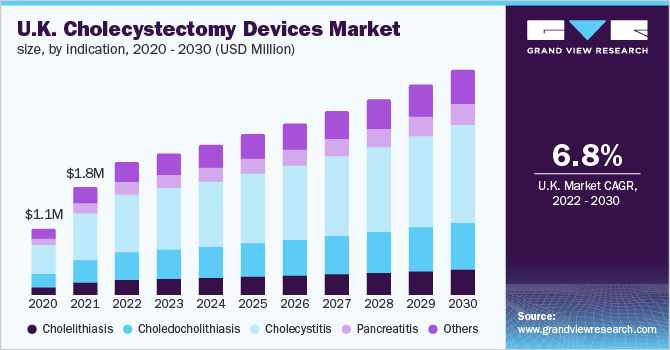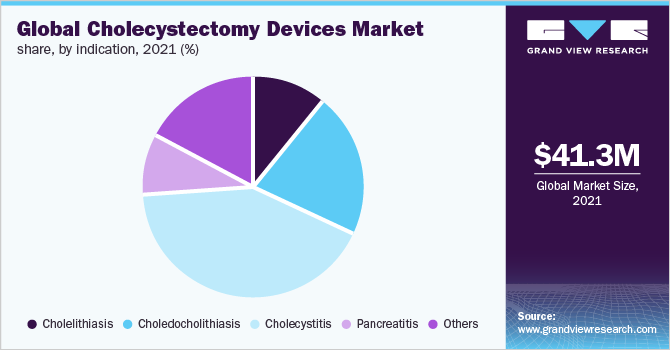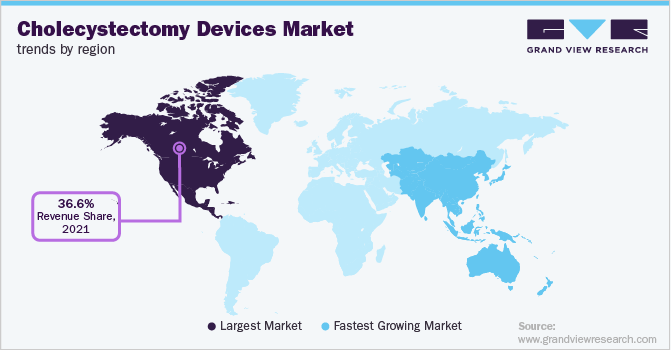- Home
- »
- Medical Devices
- »
-
Cholecystectomy Devices Market Size & Share Report, 2030GVR Report cover
![Cholecystectomy Devices Market Size, Share & Trends Report]()
Cholecystectomy Devices Market (2022 - 2030) Size, Share & Trends Analysis Report By Surgery Type (Laparoscopic, Open), By Indication (Cholecystitis, Pancreatitis), By End Use (Hospitals, ASCs), By Device, And Segment Forecasts
- Report ID: GVR-4-68039-988-0
- Number of Report Pages: 160
- Format: PDF
- Historical Range: 2017 - 2020
- Forecast Period: 2022 - 2030
- Industry: Healthcare
- Report Summary
- Table of Contents
- Segmentation
- Methodology
- Download FREE Sample
-
Download Sample Report
Report Overview
The global cholecystectomy devices market size was estimated at USD 41.34 million in 2021 and is expected to expand at a compound annual growth rate (CAGR) of 6.85% during the forecast period. The market is expected to grow owing to factors, such as the increasing prevalence of gallstone disease, the rising geriatric population, increasing preference for elective laparoscopic surgeries, and growing awareness of early disease diagnosis. In addition, factors, such as obesity, metabolic syndrome, diabetes mellitus, dyslipidemia, non-alcoholic fatty liver disease, poor dietary habits, physical inactivity, and liver cirrhosis or chronic hepatitis C virus infections, cause the development of gallstone diseases and are eventually expected to fuel the industry growth during the forecast period.

Furthermore, increasing acceptance of elective laparoscopic surgery is likely to drive the industry. For instance, with approximately 400,000 ambulatory laparoscopic cholecystectomies carried out in the United States in 2019, laparoscopic cholecystectomy is one of the most frequently done procedures. Laparoscopic cholecystectomy has been regarded as the gold standard of surgical treatment for gallstone disease since the 1990s. In addition, robotic surgery has recently grown in acceptance and usefulness in general surgery, and it could offer better outcomes to laparoscopic surgery in some gastrointestinal operations.
It has been shown that robotic cholecystectomy is a safe and effective treatment. In minimal access surgery, the robot has reportedly improved visualization, dexterity, and instrumentation. However, when compared to laparoscopic cholecystectomy, robotic cholecystectomy has longer operating times and higher hospital costs, but it is also related to shorter hospital stays and a lower re-admission rate within 90 days after the index procedure. Moreover, the rising prevalence of gallbladder diseases is also impacting the global industry. For instance, in the United States, 6.3 million men and 14.2 million women between the ages of 20 and 74 years had gallbladder disease, according to the third National Health and Nutrition Examination Survey.
The Multicenter Italian Study on Cholelithiasis (MICOL) investigated over 33,000 people in Europe between the ages of 30 and 69 years in 18 cohorts from 10 different Italian regions, and it determined that 6.5% of the men and 10.5% of the women among them had gallstones. 87% of males and 84.9% of women who had gallstones had no symptoms. According to an article published by NCBI in April 2022, around 20 million people in the U.S. are suffering from gallstone disease. Among these, nearly 300,000 cholecystectomy surgeries are performed yearly. Almost 10% are asymptomatic gallstones and around 20% are symptomatic gallstones.
The prevalence of gallstone disorders increases with increasing age, and it is predominantly found in females. In the age group of 50 to 65 years, around 5% of males and 20% of females have gallstone disorders. The rising geriatric population is driving the industry; as the risk of gallstone, disorders is more for the aged population. The population under the age of 40 years has around an 8% chance of getting gallstones whereas the group of people above the age of 70 years has an almost 50% chance of developing gallstones. In addition, the rate of cholecystectomy surgeries is increased by 60% owing to a higher inclination toward laparoscopic procedures and a rising number of elective surgeries.
However, almost 10% of patients undergoing cholecystectomy witnessed similar symptoms post-surgery, this condition is known as a post-cholecystectomy syndrome. Moreover, risk factors associated with the cholecystectomy procedures, such as wound infection, bile duct injury, retained gallstones, abscess formation, excessive bleeding, and bile duct stenosis may hamper the growth of the industry in the projection period.
Device Insights
On the basis of devices, the industry has been further segmented into conventional and robotic-assisted cholecystectomy surgery devices. The conventional surgical devices segment includes laparoscopes, energy systems, trocars, closure devices, suction/irrigation devices, insufflation devices, and hand access instruments, such as an electrode, scissors, dissectors, forceps, and grasper. The segment dominated the global industry in 2021 and accounted for the largest share of 90.00% of the total revenue. Among the conventional devices, the energy systems segment dominated the industry in 2021.
Energy systems allow rapid sequential tissue and vessel sealing, transection, and coagulation during laparoscopic cholecystectomy surgery. The laparoscope segment is expected to expand at the highest CAGR during the forecast period. A laparoscope is a small tool that has a tiny video camera and light on the end, which allows a surgeon to see inside the body without creating a larger opening. The robotic-assisted cholecystectomy surgery devices segment is expected to register the fastest CAGR during the forecast period. The robotic devices can manipulate tissue considerably more precisely than laparoscopic tools in the hands of an expert robotic surgeon.
As a result, there is a lower possibility of bleeding, bile leakage, and unintentional harm to surrounding tissues during surgery. About 3,000 incidences of common bile duct injury have been reported annually in the U.S. alone during the laparoscopic cholecystectomy era. It is conceivable that robotic cholecystectomy could lower this figure. The stated advantages of robotic-assisted cholecystectomy surgery devices include relatively shorter hospital stays and faster healing time with a noticeable reduction in post-operative pain. However, the lack of skilled professionals and the high cost of robotic devices explain the lower penetration rate and justify the lesser market size.
Surgery Type Insights
On the basis of surgery type, the global industry has been further segmented into laparoscopic cholecystectomy and open cholecystectomy. The laparoscopic cholecystectomy segment dominated the global industry in 2021 and accounted for the maximum share of more than 79.60% of the overall revenue. The laparoscopic cholecystectomy is conducted by inserting a small video camera in the abdomen with small incisions and usually takes one to two hours. Laparoscopic surgery has recently gained popularity due to its advantages, including a shorter hospital stay, less blood loss, and lower patient morbidity.
It also offers quick recovery, quick and successful outcomes, a low risk of infection, a small or no incision, and less pain. The demand for cholecystectomy devices is projected to increase during the forecast period since laparoscopic cholecystectomy surgery is in high demand. Moreover, open cholecystectomy is a conventional method used for the removal of the gallbladder, and it is only done where laparoscopic cholecystectomy surgery cannot be done safely. However, considerable factors, such as recent advancements in technology, increased preference for minimally invasive surgeries, longer postoperative hospital stays, excessive bleeding, and common bile duct injuries, have resulted in a slower growth rate and lesser market share of the segment.
Indication Insights
On the basis of indications, the global industry has been further categorized into indications, such as cholelithiasis, choledocholithiasis, cholecystitis, pancreatitis, and others. The cholecystitis segment dominated the global industry in 2021 and accounted for the largest share of more than 41.85% of the overall revenue. Cholecystitis is the condition where the gallbladder gets inflamed due to the presence of gallstones. The segment dominance is due to the high prevalence and incidence of cholecystitis. For instance, globally, the incidence rate of acute cholecystitis is around 6,300 per 100,000 in individuals below 50 years of age and 20,900 per 100,000 in individuals aged above 50 years.
The prevalence of acute cholecystitis is approximately 369 per 100,000 individuals in the United States. In addition, females are more commonly affected by gallstone diseases than males. Choledocholithiasis is expected to grow at the highest CAGR during the forecast period. Choledocholithiasis occurs when a gallstone blocks the common bile duct and bile cannot flow past it. It impedes the flow of bile from the liver to the intestine. Pressure rises resulting in elevation of liver enzymes and jaundice. It develops in about 10 to 20% of patients with gallbladder stones. Obesity, pregnancy, rapid weight loss, high fat diet, and a liver disorder are the major risk factors.
End-use Insights
Based on end-uses, the industry has been classified into hospitals, Ambulatory Surgical Centers (ASCs), and others. The hospital segment dominated the global industry in 2021 and accounted for the maximum share of more than 56.90% of the overall revenue. A rise in patients suffering from gallstone disorders and the resultant rise in surgical treatments are the factors responsible for segment expansion. Due to the simplicity of managing any crises that may develop during surgical procedures and the availability of a wide range of treatment options in such facilities, hospitals have a substantially larger patient inflow than other healthcare settings.

In addition, hospitals are the primary provider of healthcare in the majority of nations, therefore more laparoscopic procedures are performed there than in alternative healthcare facilities like clinics or surgery centers. As a result, compared to other end-use segments, the demand for laparoscopic devices is relatively high in hospitals. On the other hand, the ASCs segment is expected to witness the highest growth rate during the forecast period. The segment growth can be attributed to the rising interest in outpatient surgery, the adoption of minimally invasive treatments, and the affordability of ASC-based laparoscopic procedures. Furthermore, a high number of robotic-assisted procedures are carried out in outpatient facilities or ASCs.
Regional Insights
The industry is dominated by North America, which held a major revenue share of more than 36.55% in 2021. One of the main factors driving the region’s growth includes the high preference for laparoscopic cholecystectomy procedures over open cholecystectomy procedures. In addition, the market is impacted by the competition between well-known players in terms of product innovation. Laparoscopy is now preferred over traditional surgeries by surgeons since it encourages quick recovery and successful outcomes. Moreover, rising healthcare costs in the U.S. may encourage both new and established competitors to enter the industry.

For instance, according to the Centers for Medicaid and Medicare Services, U.S. healthcare spending was USD 4.1 trillion in 2020, or 19.7% of the country’s GDP, up 9.7% from 2019. In the Asia Pacific region, the market is expected to witness the fastest CAGR during the forecast period. This is owing to an increase in the number of advanced, well-equipped hospitals and a large volume of cholecystectomy surgical procedures. Gallstone diseases are comparatively less prevalent in developing countries. Among the developing countries, India and Taiwan have a higher prevalence of acute cholecystitis.
Australia and South Korea are some of the emerging economies in the Asia Pacific region. Advancing technology, increasing investments, improving reimbursement scenarios, and growing medical tourism is likely to drive the market in the region. Other driving factors include affordable devices, an increase in M&A activities, and supportive government initiatives to improve healthcare services. The government has made significant investments to provide basic health insurance to all citizens.
Key Companies & Market Share Insights
Due to the presence of significant opportunities in developing countries, key players are undertaking strategic initiatives, such as product development, geographical expansion, launches, mergers, and acquisitions, to increase their industry share. The da Vinci robotic-assisted surgical platform is enhanced by Intuitive Surgical's newly released Iris software and service, which converts CT images into 3D virtual models that can be seen and rotated on an iOS device before and during a robotic-assisted surgical procedure. The U.S. Food and Drug Administration has currently approved Iris for use with minimally invasive kidney treatments, and its application will be trialed in significant medical facilities around the nation. Some of the prominent players in the global cholecystectomy devices market include:
-
Surgical Holding
-
B. Braun SE
-
Surtex Instruments Ltd.
-
Sklar Surgical Instruments
-
Olympus
-
Millennium Surgical
-
Stryker Corporation
-
Medtronic
-
Intuitive Surgical
-
GerMedUSA
Cholecystectomy Devices Market Report Scope
Report Attribute
Details
Market size value in 2022
USD 50.60 million
Revenue forecast in 2030
USD 85.98 million
Growth Rate
CAGR of 6.85% from 2022 to 2030
Base year for estimation
2021
Historical data
2017 - 2020
Forecast period
2022 - 2030
Quantitative units
Revenue in USD million and CAGR from 2022 to 2030
Report coverage
Revenue forecast, company ranking, competitive landscape, growth factors, and trends
Segments covered
Device, surgery type, indication, end-use, region
Regional scope
North America; Europe; Asia Pacific; Latin America; MEA
Country scope
U.S.; Canada; U.K.; Germany; France; Italy; Spain; Russia; Japan; India; China; Australia; South Korea; Brazil; Mexico; Argentina; Columbia; South Africa; Saudi Arabia; UAE; Turkey;
Key companies profiled
Surgical Holding; B. Braun SE; Surtex Instruments Limited.; Sklar Surgical Instruments; Olympus; Millennium Surgical; Stryker Corp.; Medtronic; Intuitive Surgical; GerMedUSA
Customization scope
Free report customization (equivalent up to 8 analysts working days) with purchase. Addition or alteration to country, regional & segment scope
Pricing and purchase options
Avail customized purchase options to meet your exact research needs. Explore purchase options
Global Cholecystectomy Devices Market Segmentation
This report forecasts revenue growth at global, regional, and country levels and provides an analysis of the latest industry trends in each of the sub-segments from 2017 to 2030. For this study, Grand View Research has segmented the global cholecystectomy devices market report based on device, surgery type, indication, and, end-use, and region:
-
Device Outlook (Revenue, USD Million, 2017 - 2030)
-
Conventional Cholecystectomy Devices
-
Laparoscopes
-
Energy Systems
-
Trocars
-
Closure Devices
-
Suction/ Irrigation Device
-
Insufflation Device
-
Hand Access Instruments
-
-
Robotic-assisted Cholecystectomy Surgery Devices
-
-
Surgery Type Outlook (Revenue, USD Million, 2017 - 2030)
-
Laparoscopic Cholecystectomy
-
Open Cholecystectomy
-
-
Indication Outlook (Revenue, USD Million, 2017 - 2030)
-
Cholelithiasis
-
Choledocholithiasis
-
Cholecystitis
-
Pancreatitis
-
Others
-
-
End-use Outlook (Revenue, USD Million, 2017 - 2030)
-
Hospitals
-
Ambulatory Surgical Centers
-
Others
-
-
Regional Outlook (Revenue, USD Million, 2017 - 2030)
-
North America
-
U.S.
-
Canada
-
-
Europe
-
U.K.
-
Germany
-
France
-
Italy
-
Spain
-
Russia
-
-
Asia Pacific
-
Japan
-
China
-
India
-
Australia
-
South Korea
-
-
Latin America
-
Mexico
-
Brazil
-
Argentina
-
Colombia
-
-
Middle East & Africa
-
South Africa
-
Saudi Arabia
-
UAE
-
Turkey
-
-
Frequently Asked Questions About This Report
b. The global cholecystectomy devices market size was estimated at USD 41.34 million in 2021 and is expected to reach USD 50.60 million in 2022.
b. The global cholecystectomy devices market is expected to grow at a compound annual growth rate of 6.85 % from 2022 to 2030 to reach USD 85.98 million by 2030.
b. North America dominated the cholecystectomy devices market with a share of 36.58% in 2021. One of the main factors driving the market is the growing preference for laparoscopic cholecystectomy procedures over open cholecystectomy procedures.
b. Some key players operating in the cholecystectomy devices market include Surgical Holding, B. Braun SE, Surtex Instruments Limited, Sklar Surgical Instruments, Olympus Corporation, Millennium Surgical, Stryker Corporation, Medtronic, Intuitive Surgical, and GerMedUSA.
b. The market is expected to grow owing to factors such as the increasing prevalence of gallstone disease, the rising geriatric population, increasing preference for elective laparoscopic surgeries, and growing awareness of early disease diagnosis.
Share this report with your colleague or friend.
Need a Tailored Report?
Customize this report to your needs — add regions, segments, or data points, with 20% free customization.

ISO 9001:2015 & 27001:2022 Certified
We are GDPR and CCPA compliant! Your transaction & personal information is safe and secure. For more details, please read our privacy policy.
Trusted market insights - try a free sample
See how our reports are structured and why industry leaders rely on Grand View Research. Get a free sample or ask us to tailor this report to your needs.










